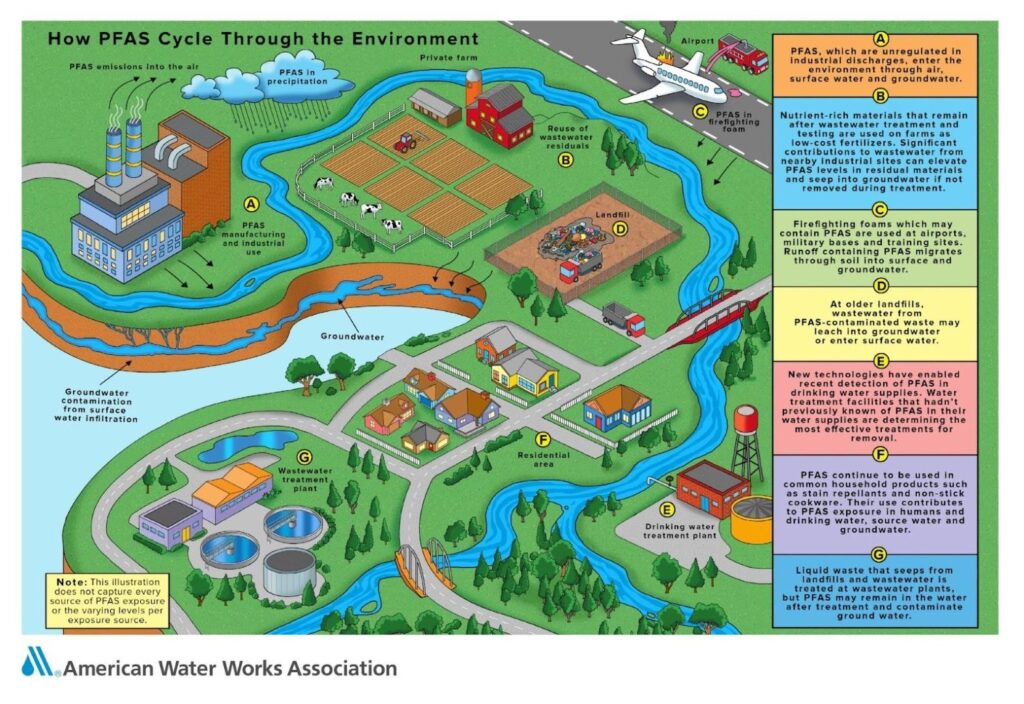As we mark the 50th anniversary of the Safe Drinking Water Act (SDWA) in 2024, it’s important to reflect on the progress we’ve made in ensuring access to clean, safe drinking water across the United States. Since the advent of SDWA, communities have moved towards a more holistic approach to treating and improving their water supplies, and the management of public water resources is becoming an integrated process across the entire water lifecycle.
One of most prescient issues for clean water today is the presence and treatment of per- and polyfluoroalkyl substances (PFAS) in the water lifecycle. PFAS are a group of synthetic chemicals that have been widely used in industrial and consumer products. These chemicals can accumulate in water sources and pose potential health risks even at low levels of exposure.

PFAS have become a central focus in the evolving landscape of the SDWA and water safety in 2024 and for the next five years. This past April, the EPA finalized the PFAS National Primary Drinking Water Regulation, which set maximum contaminant limits for five individual PFAS substances. The regulation also included a rapid compliance schedule, requiring public water systems to complete initial PFAS monitoring in their water supply by 2027 and plan for solutions in their water supply by 2027 and implement solutions that reduce PFAS to regulatory levels by 2029.

Complying with these regulations has led water purveyors to explore new, advanced treatment technologies to monitor and remove these substances from drinking water sources and supplies.
Evolving Solutions for PFAS Challenges
As STV works with water providers to model and implement PFAS solutions and manage this new regulatory landscape, we are excited to work with and apply several innovative PFAS treatment technologies.
Separation/Adsorbent Medias
Adsorbent media for PFAS treatment works by utilizing the physical and chemical properties of certain media to attract, bind, replace and eliminate PFAS molecules in water. There are several current and emerging media types for this type of treatment in this realm.
One option is using Granular Activated Carbon (GAC), which effectively removes PFAS by attracting them to its large surface area and adsorption properties.

Ion Exchange (IX) is an advanced water treatment process that utilizes functional resin beads to selectively exchange ions with PFAS compounds. This mechanism enhances the removal of long-chain and short-chain PFAS.

Other advanced engineering medias are available for superior adsorbent capacities and enhanced efficiency in PFAS removal. Due to its high removal capacity for PFAS, adsorbent media treatments can offer a highly reliable, efficient and scalable solution for reducing PFAS concentrations.
Nanofiltration and Reverse Osmosis
Nano Filtration (NF) and Reverse Osmosis (RO) are advanced membrane filtration technologies for PFAS removal. These processes allow smaller molecules to pass through while blocking and rejecting larger molecules found in PFAS compounds. There are several options for this selective permeation:
- Nanofiltration (NF) techniques use semi-permeable membranes with pore sizes between 1–10 nanometers to filter out larger PFAS molecules while permitting the passage of smaller ions.
- Reversos Osmosis (RO) provides a higher degree of separation by using sub-micron filtration capabilities. By using fine pores and high-pressure processes, RO can effectively remove a wide range of PFAS compounds.
Both technologies offer scalable, high-efficiency solutions for PFAS removal. However, these solutions require a more complex operation than other solutions and require both a pretreatment process and a post-treatment process to manage the PFAS-laden water filtered out during the NF or RO process.

Surface Active Foam Fractionation (SAFF)
Surface Active Foam Fractionation (SAFF) is a specialized separation technique for PFAS removal. SAFF utilizes surfactant-induced foaming to selectively capture and concentrate PFAS compounds from water.
By exploiting differences in surface activity, SAFF efficiently isolates PFAS from water, offering a scalable, high-performance solution for contaminant removal in complex water systems. Additionally, SAFF is an ideal solution to reduce the volume of waste generated from PFAS-laden reject water in Nano Filtration and Reverse systems, enhancing overall treatment efficiency and sustainability.

Determining which of these treatments would be the most effective solution is highly dependent on local conditions, including water sources and co-contaminates. To help providers determine the most effective solution for their PFAS challenges, STV is using AI technologies like Transcend to model many different PFAS solutions and their potential impact on operations. This modeling not only enables water providers to compare treatment options and their capacity/effectiveness, but it also allows providers to make the most compelling case to source funding for PFAS projects.
Funding Opportunities for Implementing New PFAS Treatments
The financial challenges of implementing these new technologies and monitoring and removing PFAS in the water supply remain significant, especially for smaller and/or underserved communities. Federal funding offers vital resources for local utilities to address PFAS challenges.
- The 2021 Bipartisan Infrastructure Law allocates $21 billion in funds for drinking water safety, including $5 billion specifically for addressing PFAS contamination in drinking water. This fiscal fund enables communities to implement PFAS treatment technologies, conduct necessary monitoring and testing, and enhance water infrastructure.
- The 2014 Water Infrastructure Finance and Innovation Act (WIFIA) provides low-interest loans to public water systems for large-scale water and wastewater infrastructure projects and has become a key mechanism for funding efforts to tackle PFAS contamination. Through WIFIA, providers can access financing for the construction of treatment plants, installation of advanced filtration systems, and upgrading of water treatment processes.
These programs are designed to make large projects more affordable and accessible, helping municipalities take proactive steps to evaluate and reduce PFAS levels in drinking water.
As we work with providers to plan and implement these emerging PFAS technologies, STV’s water experts have helped communities apply for, win, and leverage these federal funds to treatment opportunities in their water and wastewater facilities.
Implementing the Next Generation of Clean Water
The 50th anniversary of the SDWA provides a timely opportunity to celebrate the strides made nationwide to protect our water supplies and also evaluate how communities can tackle the treatment of emerging contaminants such as PFAS.
We are at a crossroads where new treatment technologies, regulatory frameworks, and public awareness are playing crucial roles in tackling PFAS treatment options. By taking advantage of federal funding and implementing emerging technology solutions throughout the water treatment cycle holistically, STV is at the forefront of helping communities reach the next generation of clean water.








